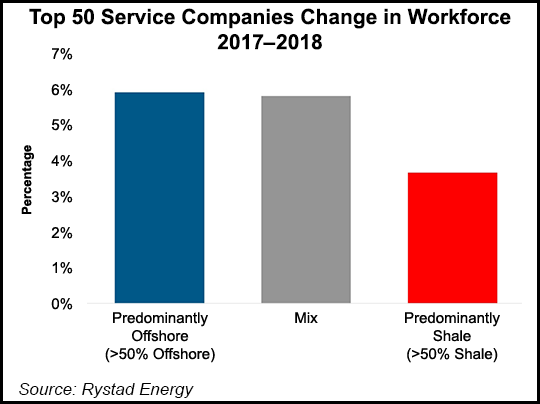E&P | Markets | NGI All News Access
Tide Turning for Offshore Oil, Gas Jobs Market as Project Sanctioning Expands
The once steady jobs in onshore services has begun to retrench, with more people hired for the offshore oil and gas sector, according to an analysis by Rystad Energy.

In a review of oilfield services (OFS) sectors with the highest percent change of employment, the offshore industry was in the lead, with increasing year/year growth in 2018 among the top 50 global operators.
“This is a clear effect of the increase in offshore sanctioning,” said Rystad’s Matthew Fitzsimmons, vice president of the OFS team. “We expect offshore commitments to nearly double from 2018 to 2020 and sustain high levels of spending over the next five years.”
The demand for offshore services is forecast to reach $442 billion in 2025, a 45% increase over 2018.
Companies exposed to the offshore industry had struggled with the “financial realities of reduced activity in 2015-2017, resulting in a cumulative workforce decrease of 31%,” according to Rystad. However, the tide has turned.
“Four out of the top five oilfield service companies with the largest workforce change from 2017 to 2018 were primarily exposed to the offshore industry,” analysts noted.
Among the smaller players with a strong focus on offshore segments, Norwegian shipping company Solstad nearly doubled its workforce from 2017, a significant ramp that bet on the long-term improvement in market conditions.
Similarly, drilling contractor Seadrill’s employment grew by 15%. The company recently was awarded contracts with Equinor SA and Saudi Arabia Oil Co., aka Aramco. However, Seadrill’s 2018 year-end headcount was only 100 people more than it was after layoffs in 2016, and it remains slightly more than half of what it was in 2014.
“We expect Seadrill’s hiring need to continue through 2022, as the markets the company is exposed to will continue to grow, offering contracting opportunities,” Fitzsimmons said.
When Seadrill and other offshore-centric operators attempt to hire more people, they may face some of the same hiring challenges many other offshore OFS operators are dealing with today.
“Our informal interviews with OFS company leaders across the offshore industry all echoed a common challenge: how to bring experienced personnel back into the industry amidst current growth, and how to attract new talent,” Fitzsimmons said.
“History would show that to bring back experienced professionals into an industry, higher wages will be required.”
Not all hiring trends are as optimistic for the OFS sector, Rystad’s team noted. For example, Bristow reduced its labor force from 2017 to 2018 to decrease operational costs and address financial insecurity. The move proved to be insufficient, and the company filed for Chapter 11 protection in May.
© 2024 Natural Gas Intelligence. All rights reserved.
ISSN © 1532-1231 | ISSN © 2577-9877 |
